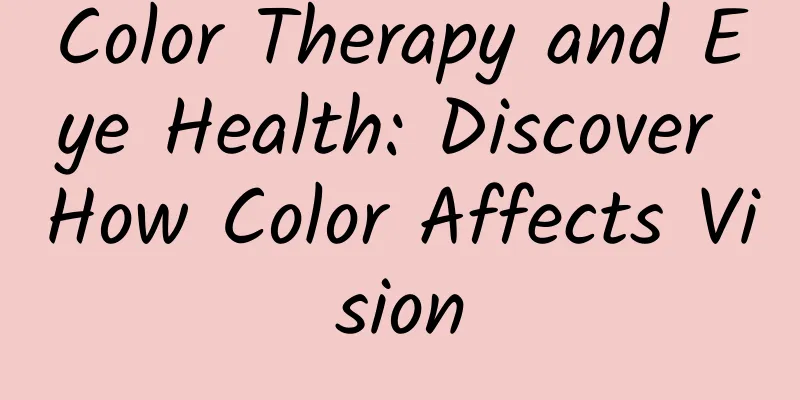Color Therapy and Eye Health: Discover How Color Affects Vision

|
In this colorful world, colors not only decorate our lives, but also have a profound impact on our physical and mental health. Especially in the field of eye health, color therapy, as an emerging treatment method, is gradually attracting people's attention. So, how does color affect our vision? What are the specific effects of different colors on the eyes? The Secret of Color TherapyColor therapy, as the name suggests, is a treatment method that stimulates the visual system through different colors of light to promote visual rehabilitation and improve eye health. It uses the characteristics of color, such as wavelength and brightness, to affect the physiological function and psychological state of the eye. Effects of different colors on the eyesBlue: soothing and relaxing, promoting sleepBlue is often thought to have a soothing and relaxing effect. When we gaze at blue, such as the sky or the sea, it can help relieve eye fatigue and tension. In color therapy, blue light is used to promote sleep, allowing the eyes and emotions to be fully rested and restored. However, it should be noted that dark blue may over-stimulate the eyes, so it is recommended to choose a lighter blue. Green: Balance adjustment, reduce eye fatigueGreen is the most common color in nature. It absorbs light moderately, can relax the eyes, relieve visual fatigue, and help prevent myopia. Green light can also absorb harmful ultraviolet rays and reduce eye irritation. In color therapy, green therapy is widely used to adjust the eye's sensitivity to light and reduce eye discomfort and fatigue. Yellow: Brightens the field of view and enhances contrastYellow light has the effect of brightening vision and enhancing contrast. In visual rehabilitation, yellow therapy can help improve vision problems, enhance the eye's ability to perceive details and colors, and improve visual clarity and comfort. However, excessive yellow may irritate the optic nerve, so it should be used in moderation. Red: Stimulates energy and improves concentrationRed light is believed to stimulate vitality and improve concentration. In color therapy, red therapy can help improve eye fatigue and concentration problems, revitalize the eyes, and improve work and study efficiency. However, long-term exposure to red light may cause visual fatigue, so the use time should be reasonably controlled. Orange and Rainbow Colors: Promote Emotional BalanceOrange is a vibrant and enthusiastic color that can elevate mood and bring a sense of joy. In color therapy, orange is used to relieve eye fatigue and improve mood. The rainbow color spectrum includes a variety of colors, each with a unique effect that can promote emotional balance and psychological relaxation, bringing a positive mood and a sense of joy. Color therapy considerationsAlthough color therapy has certain potential in improving eye health and mood, we also need to pay attention to the rationality and moderation of its use. First, color therapy cannot completely replace professional medical and eye care. Patients with eye diseases or serious emotional problems still need to seek help from professional doctors. Secondly, the use of color should not be excessive or inappropriate, so as not to cause visual fatigue or other discomfort. Finally, we should maintain a rational attitude towards color therapy and combine it with other healthy lifestyles to comprehensively improve our physical and mental state. Color therapy provides us with the possibility of exploring new ways to improve eye health. By properly utilizing the characteristics of different colors, we can inject healing light into the eyes, so that both the eyes and the mind can benefit from it. However, we also need to be cautious and moderate in the use process to ensure that color therapy can truly play its positive role. Let us explore the charm of color together and light up the road to visual rehabilitation!For more popular science related to ophthalmology, you can follow Tejingcai About Dr. Jingcai: The main creators of Tejingcai's popular science content all have a professional background in ophthalmology, a master's degree or above, and are former ophthalmologists. For some popular science content with a higher degree of professionalism, we will also invite working ophthalmologists and optometry experts to review and check it, striving to be responsible for the accuracy of the content and avoid misleading readers. |
>>: Will allergic rhinitis improve and heal itself with age?
Recommend
The difference between gestational sac and boy
When a pregnant mother learns that she is pregnan...
What causes breast pain in early pregnancy
During pregnancy, many women will experience naus...
Female facial mole diagram
The art of fortune-telling includes palmistry, fa...
Pregnant woman with right chest and armpit pain
A woman's body will undergo many changes duri...
How to drain the fluid in the uterus
When it comes to endometritis, I think everyone i...
This sentence you have been told since childhood may be destroying your health
Our parents have always emphasized this to us sin...
Menstrual blood is dark brown
Once a woman enters puberty, she will have her pe...
Hawthorn can make menstruation smooth
"When it comes to hawthorn, the first thing ...
What are the effects of high blood pressure in late pregnancy on the fetus?
High blood pressure during pregnancy is actually ...
Seven exercises to improve limited shoulder mobility after breast cancer surgery
The breast cancer surgery went smoothly, but my s...
What should girls eat if they have anemia?
Once a person suffers from anemia, the blood'...
6 things to note when using medication for women's private parts
Gynecological medications should be used consiste...
What are the harms of taking birth control pills regularly to your body?
Emergency contraception mainly contains estrogen ...
Survey shows that the average number of apps installed on each mobile phone is 80, and WeChat has expanded 575 times in 11 years
Recently, a survey report showed that on average,...
The cervix is a little eroded
Cervical erosion is one of the common symptoms of...









